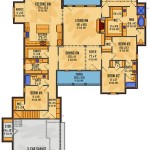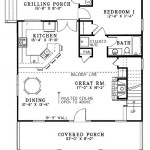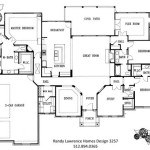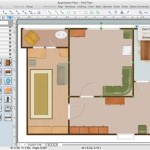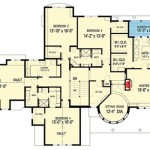Open Floor Plan House Ideas: Maximizing Space and Light
Open floor plans have become increasingly popular in modern home design, offering a sense of spaciousness, enhanced natural light, and improved flow between living areas. This design approach eliminates or minimizes walls separating key areas like the living room, dining room, and kitchen, creating a single, unified space. While aesthetically appealing, designing an open floor plan requires careful consideration of layout, functionality, and visual cohesion.
The versatility of an open floor plan makes it suitable for various lifestyles and home sizes. It is particularly beneficial for smaller homes, as it creates the illusion of more space and avoids feeling cramped. In larger homes, an open floor plan can foster a sense of connection and encourage interaction between family members. Successful implementation, however, hinges on thoughtful planning and strategic design choices.
Defining Zones Through Furniture Placement
One of the primary challenges in an open floor plan is creating distinct areas without the use of physical walls. Furniture placement is a crucial tool for achieving this separation and defining zones for different activities. Strategic arrangement of sofas, chairs, tables, and bookshelves can establish visual boundaries and create functional spaces within the larger open area.
A large sectional sofa, for example, can effectively delineate the living room area from the dining area. Placing the back of the sofa towards the dining space acts as a subtle barrier, visually separating the two zones without completely blocking the view. Similarly, a long console table or a bookshelf placed strategically can serve as a divider between the living room and the entrance hallway.
Area rugs are another effective way to define zones. A large area rug placed under the seating arrangement in the living room creates a visual anchor and defines the space. Different rugs can be used in different zones to further emphasize the separation. For example, a vibrant rug under the dining table can contrast with a more neutral rug in the living room, creating a clear distinction between the two areas.
In the kitchen area, the placement of the island or peninsula is critical. These features not only provide additional counter space and storage but also act as natural dividers between the kitchen and the living or dining area. The island can serve as a breakfast bar, a preparation station, or a social gathering point, creating a seamless transition between the kitchen and the rest of the open space.
Consider the flow of traffic when arranging furniture. Ensure that there are clear pathways between zones to avoid creating bottlenecks or awkward navigation. The furniture arrangement should facilitate easy movement and encourage interaction within and between the different areas.
Utilizing Color and Texture to Create Visual Interest
While open floor plans aim to create a unified space, incorporating varying colors and textures is essential for adding visual interest and preventing the space from feeling monotonous. A cohesive color palette should be selected, but variations in tone and texture can be used to differentiate between zones and highlight specific features.
For instance, a neutral color palette can be used as a base throughout the open space, with pops of color introduced through accent walls, furniture, or accessories. An accent wall in the living room can draw attention to a focal point, such as a fireplace or a piece of artwork. Different shades of the same color can be used in different zones to create a subtle but effective distinction.
Texture plays a crucial role in adding depth and dimension to an open floor plan. Mixing different textures, such as plush fabrics, smooth wood, and rough stone, can create a tactile experience and make the space more inviting. For example, a velvet sofa can be paired with a jute rug and wooden coffee table to create a layered and visually appealing living room area.
Consider using different wall finishes in different zones. A textured wallpaper in the dining area can add a touch of elegance, while a smooth paint finish in the living room can create a more modern look. Varying the wall finishes can further define the different areas within the open space.
Lighting is another important element in creating visual interest. Use a combination of ambient, task, and accent lighting to highlight different areas and create a layered lighting scheme. Pendant lights over the kitchen island can provide task lighting and add a decorative touch, while floor lamps in the living room can create a warm and inviting atmosphere.
Optimizing Natural Light and Ventilation
One of the key benefits of an open floor plan is the ability to maximize natural light and ventilation throughout the home. With fewer walls obstructing the flow of light and air, the space feels brighter, more open, and more connected to the outdoors. Maximizing these benefits requires careful planning and attention to window placement, orientation, and ventilation strategies.
Maximize the size and number of windows to allow ample natural light to flood the open space. Large windows or sliding glass doors can provide stunning views and create a seamless connection between the interior and exterior. Consider the orientation of the windows to optimize sunlight exposure throughout the day. South-facing windows provide the most sunlight during the winter months, while east-facing windows provide morning light and west-facing windows provide afternoon light.
Skylights are another excellent way to bring natural light into an open floor plan, particularly in areas that may not have access to direct sunlight. Skylights can be strategically placed above the kitchen island, the dining area, or the living room to brighten the space and create a more inviting atmosphere.
Proper ventilation is crucial for maintaining a comfortable and healthy indoor environment. Ensure that the open floor plan is well-ventilated with strategically placed windows and doors that allow for cross-ventilation. Consider installing ceiling fans or exhaust fans to improve air circulation and remove stale air.
Landscaping can also play a role in optimizing natural light and ventilation. Plant trees and shrubs strategically to provide shade and block unwanted sunlight during the summer months, while allowing sunlight to penetrate during the winter months. Consider using permeable paving materials to improve drainage and reduce heat absorption around the home.
Window treatments can also be used to control the amount of natural light entering the open space. Sheer curtains or blinds can filter the light and provide privacy without completely blocking the view. Blackout curtains can be used in bedrooms or media rooms to block out light for sleeping or watching movies.
Maintaining Cohesion Through Design Elements
While defining zones is important, maintaining a cohesive design aesthetic throughout the open floor plan is crucial for creating a harmonious and visually pleasing space. This can be achieved through careful selection of materials, colors, furniture styles, and decorative accessories.
Choose a consistent flooring material throughout the open space to create a sense of continuity. Hardwood floors, tile, or concrete are all excellent choices that can be used in a variety of styles and finishes. If different flooring materials are used in different zones, ensure that they complement each other and create a smooth transition between the areas.
Select a consistent color palette that is used throughout the open space. Choose a base color that is used on the walls and ceilings, and then introduce accent colors through furniture, accessories, and artwork. The color palette should be cohesive and create a sense of harmony throughout the space.
Choose furniture styles that complement each other and create a unified look. Consider the overall style of the home and select furniture that is consistent with that style. Avoid mixing too many different styles, as this can create a cluttered and disjointed look.
Use decorative accessories to tie the space together. Artwork, rugs, pillows, and throws can all be used to add color, texture, and personality to the open floor plan. Choose accessories that complement the overall design aesthetic and create a sense of cohesion throughout the space.
Pay attention to the details. Small details, such as door hardware, light fixtures, and trim, can have a big impact on the overall look and feel of the open floor plan. Choose details that are consistent with the overall design aesthetic and create a sense of continuity throughout the space.
Addressing Noise Control in Open Spaces
One of the potential drawbacks of an open floor plan is the lack of sound insulation between different areas. Noise from the kitchen can easily travel to the living room, and conversations in the dining area can be heard throughout the open space. Addressing noise control is essential for creating a comfortable and functional open floor plan.
Soft surfaces can help to absorb sound and reduce echo. Use rugs, curtains, and upholstered furniture to absorb sound and create a quieter environment. Wall hangings and tapestries can also help to absorb sound and add visual interest to the space.
Acoustic panels can be used to absorb sound and reduce noise levels. Acoustic panels are available in a variety of styles and colors, and they can be easily installed on walls or ceilings. Consider using acoustic panels in areas where noise is a particular concern, such as the living room or the home office.
Consider using sound-absorbing materials in the construction of the home. Insulating walls and ceilings with sound-absorbing materials can help to reduce noise transmission between different areas. Double-paned windows can also help to reduce noise from outside.
Use sound-dampening appliances in the kitchen. Look for appliances that are designed to operate quietly, such as dishwashers and refrigerators. Consider installing a range hood that effectively vents smoke and odors without creating excessive noise.
Consider the layout of the open floor plan when addressing noise control. Locate noisy areas, such as the kitchen and the playroom, away from quiet areas, such as the bedrooms and the home office. This can help to minimize noise disturbance and create a more peaceful environment.
These design considerations, when carefully implemented, will allow homeowners to fully realize the potential of open floor plan living.
House Design Trends What S Popular In Cur Floor Plans Extra Space Storage

Pros And Cons Of An Open Concept Floor Plan Generation Homes Nw

Modern Open Floor House Plans Blog Eplans Com

Open Floor Plans Build A Home With Smart Layout Blog Dreamhomesource Com
:max_bytes(150000):strip_icc()/1660-Union-Church-Rd-Watkinsville-Ga-Real-Estate-Photography-Mouve-Media-Web-9-77b64e3a6fde4361833f0234ba491e29.jpg?strip=all)
18 Open Floor House Plans Built For Entertaining

Modern Open Floor House Plans Blog Eplans Com

Simple Design Ideas To Create An Outstanding Open Floor Plan Lita Dirks Co Award Winning Interior And Merchandising Firm

30 Gorgeous Open Floor Plan Ideas How To Design Concept Spaces

House Floor Plans Your Best Guide To Home Layout Ideas

Pros And Cons Of Open Concept Floor Plans



